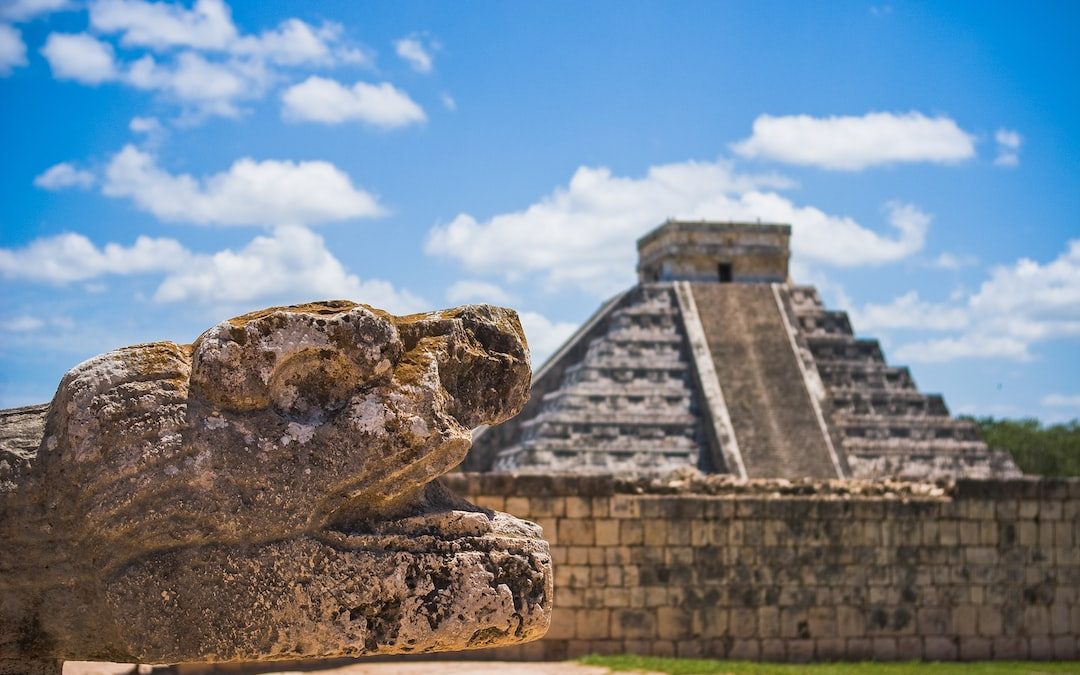Table of Contents
Exploring the Magnificent Mayan Ruins of Mexico
Mexico is a country steeped in a rich history, and its Mayan ruins are some of the most spectacular archaeological sites in the world. From the remote jungles of the Yucatan Peninsula to the bustling cities of the Gulf Coast, the ancient Mayan civilization left its mark on Mexico in the form of grand pyramids, sacred temples, and mysterious hieroglyphics. This post will explore the history and wonders of some of Mexico’s most impressive Mayan ruins.
The Magnificence of Chichen Itza
The ancient city of Chichen Itza is one of the most impressive Mayan ruins in Mexico. Located in the Yucatan Peninsula, this archaeological site was once a major center of political power and religious activity. It is home to the iconic El Castillo pyramid, which is the centerpiece of the city and the most famous Mayan structure in the world. Visitors to Chichen Itza can also explore the ruins of the Temple of the Warriors, the Sacred Cenote, and the Great Ball Court, all of which offer a glimpse into the grandeur of this ancient city.
The El Castillo pyramid is a marvel of engineering, standing at 75 feet tall and constructed with a combination of stone blocks and limestone mortar. The four sides of the pyramid are aligned perfectly with the four directions of the compass, and the temple at the top is dedicated to the god Kukulkan. Visitors to Chichen Itza can climb to the top of the pyramid for a breathtaking view of the surrounding jungle.
The Temple of the Warriors is a complex of pyramids and plazas that was used for religious ceremonies and sacrifices. The temple is adorned with relief sculptures of warriors, gods, and animals, and its central plaza is surrounded by an impressive colonnade of columns. The Sacred Cenote is a natural pool believed to be a gateway to the underworld, and the Great Ball Court, the largest in the ancient Mayan world, is where a ritual ball game was played.
The Towering Pyramid of Tulum
The ancient city of Tulum is located on the Gulf Coast of Mexico, and its most notable feature is the El Castillo pyramid, a towering structure that overlooks the Caribbean Sea. This impressive structure was once used as a fortress to guard the city and protect its inhabitants from invaders. Visitors to Tulum can also explore the ruins of the Temple of the Winds, the Temple of the Frescoes, and the Temple of the Descending God, all of which offer insight into the fascinating history of this ancient city.
The El Castillo pyramid is the most iconic structure in Tulum, standing at 30 feet tall and constructed from limestone blocks and mortar. The pyramid was dedicated to the god Quetzalcoatl, and its four sides are aligned perfectly with the four directions of the compass. Visitors to Tulum can climb to the top of the pyramid for a stunning view of the Caribbean Sea.
The Temple of the Winds is dedicated to the god Ehecatl and features a unique doorway that is aligned with the direction of the wind. The Temple of the Frescoes is adorned with colorful murals that depict scenes from the Mayan gods and goddesses, while the Temple of the Descending God is dedicated to the god of resurrection and features a unique sculpture of a figure descending from the sky.
The Ancient City of Palenque
The ancient city of Palenque is located in the jungles of Chiapas, and its ruins are some of the most impressive Mayan sites in Mexico. This archaeological site was once a major center of political power and religious activity, and it is home to the iconic Temple of Inscriptions, the Temple of the Sun, and the Temple of the Cross, all of which offer a glimpse into the grandeur of this ancient city.
The Temple of Inscriptions is the largest structure in Palenque, standing at 75 feet tall and constructed with a combination of stone blocks and limestone mortar. The temple is adorned with intricate carvings and hieroglyphics, and its walls are lined with several chambers that were used for religious ceremonies and sacrifices. The Temple of the Sun is dedicated to the god Kinich Ahau and features a unique circular door that is aligned with the sun’s path through the sky.
The Temple of the Cross is a complex of pyramids and plazas that was used for religious ceremonies and sacrifices. The temple is adorned with relief sculptures of gods and goddesses, and its central plaza is surrounded by an impressive colonnade of columns. Visitors to Palenque can also explore the ruins of the Palace, a sprawling complex of courtyards and temples, and the Aqueduct, a network of canals and pools that supplied the city with fresh water.
The Remarkable Ruins of Uxmal
The ancient city of Uxmal is located in the Yucatan Peninsula, and its ruins are some of the most spectacular Mayan sites in Mexico. This archaeological site was once a major center of political power and religious activity, and it is home to the iconic Pyramid of the Magician, the Governor’s Palace, and the Nunnery Quadrangle, all of which offer a glimpse into the grandeur of this ancient city.
The Pyramid of the Magician is the most iconic structure in Uxmal, standing at 75 feet tall and constructed with a combination of stone blocks and limestone mortar. The pyramid is dedicated to the god Itzamna, and its four sides are aligned perfectly with the four directions of the compass. Visitors to Uxmal can climb to the top of the pyramid for a breathtaking view of the surrounding jungle.
The Governor’s Palace is the largest structure in Uxmal, a sprawling complex of courtyards and temples. The palace is adorned with intricate carvings and relief sculptures, and its walls are lined with several chambers that were used for religious ceremonies and sacrifices. The Nunnery Quadrangle is a complex of plazas and pyramids that was used for religious ceremonies and sacrifices.
The Mysterious Ruins of Coba
The ancient city of Coba is located in the jungles of the Yucatan Peninsula, and its ruins are some of the most mysterious Mayan sites in Mexico. This archaeological site was once a major center of political power and religious activity, and it is home to the iconic Nohoch Mul pyramid, the Temple of the Cross, and the Great Plaza, all of which offer a glimpse into the grandeur of this ancient city.
The Nohoch Mul pyramid is the most iconic structure in Coba, standing at 120 feet tall and constructed with a combination of stone blocks and limestone mortar. The pyramid is dedicated to the god Itzamna, and its four sides are aligned perfectly with the four directions of the compass. Visitors to Coba can climb to the top of the pyramid for a stunning view of the surrounding jungle.
The Temple of the Cross is a complex of pyramids and plazas that was used for religious ceremonies and sacrifices. The temple is adorned with relief sculptures of gods and goddesses, and its central plaza is surrounded by an impressive colonnade of columns. The Great Plaza is the largest open space in Coba, and it was once used as a marketplace and gathering place for the city’s inhabitants.
The Majestic Ruins of Calakmul
The ancient city of Calakmul is located in the jungles of Campeche, and its ruins are some of the most majestic Mayan sites in Mexico. This archaeological site was once a major center of political power and religious activity, and it is home to the iconic Pyramid of the Seven Stories, the Temple of the Owl, and the Great Plaza, all of which offer a glimpse into the grandeur of this ancient city.
The Pyramid of the Seven Stories is the most iconic structure in Calakmul, standing at 120 feet tall and constructed with a combination of stone blocks and limestone mortar. The pyramid is dedicated to the god Itzamna, and its four sides are aligned perfectly with the four directions of the compass. Visitors to Calakmul can climb to the top of the pyramid for a breathtaking view of the surrounding jungle.
The Temple of the Owl is dedicated to the god of war and features a unique sculpture of an owl perched atop the pyramid. The Great Plaza is the largest open space in Calakmul, and it was once used as a marketplace and gathering place for the city’s inhabitants. Visitors to Calakmul can also explore the ruins of the Palace, a sprawling complex of courtyards and temples.
The Spectacular Ruins of Monte Alban
The ancient city of Monte Alban is located in the mountains of Oaxaca, and its ruins are some of the most spectacular Mayan sites in Mexico. This archaeological site was once a major center of political power and religious activity, and it is home to the iconic Grand Plaza, the Temple of Danzantes, and the Tombs of Monte Alban, all of which offer a glimpse into the grandeur of this ancient city.
The Grand Plaza is the largest open space in Monte Alban, and it was once used as a marketplace and gathering place for the city’s inhabitants. The Temple of Danzantes is a complex of plazas and pyramids that was used for religious ceremonies and sacrifices, and it is adorned with relief sculptures of gods and goddesses. The Tombs of Monte Alban are a network of underground chambers that were used for burials and offerings.
The Grandeur of Teotihuacan
The ancient city of Teotihuacan is located in the Valley of Mexico, and its ruins are some of the most grandiose Mayan sites in Mexico. This archaeological site was once a major center of political power and religious activity, and it is home to the iconic Pyramid of the Sun, the Pyramid of the Moon, and the Avenue of the Dead, all of which offer a glimpse into the grandeur of this ancient city.
The Pyramid of the Sun is the most iconic structure in Teotihuacan, standing at 200 feet tall and constructed with a combination of stone blocks and limestone mortar. The pyramid is dedicated to the god Quetzalcoatl, and its four sides are aligned perfectly with the four directions of the compass. Visitors to Teotihuacan can climb to the top of the pyramid for a breathtaking view of the surrounding valley.
The Pyramid of the Moon is the second largest structure in Teotihuacan, standing at 140 feet tall and constructed from limestone blocks and mortar. The pyramid is dedicated to the god Tlaloc, and its four sides are aligned perfectly with the four directions of the compass. The Avenue of the Dead is a wide stone roadway that connects the city’s most important structures, and it is lined with several smaller pyramids that were used for religious ceremonies and sacrifices.
The Mystical Ruins of El Tajin
The ancient city of El Tajin is located in the state of Veracruz, and its ruins are some of the most mystical Mayan sites in Mexico. This archaeological site was once a major center of political power and religious activity, and it is home to the iconic Pyramid of the Niches, the Temple of the Sun, and the Ball Court, all of which offer a glimpse into the grandeur of this ancient city.
The Pyramid of the Niches is the most iconic structure in El Tajin, standing at 90 feet tall and constructed with a combination of stone blocks and limestone mortar. The pyramid is adorned with intricate carvings and relief sculptures, and its walls are lined with several chambers that were used for religious ceremonies and sacrifices. The Temple of the Sun is dedicated to the god Kinich Ahau and features a unique circular door that is aligned with the sun’s path through the sky.
The Ball Court is the largest open space in El Tajin, and it was once used as a marketplace and gathering place for the city’s inhabitants. The court is also home to a unique sculpture of a figure descending from the sky, believed to be the god of resurrection. Visitors to El Tajin can also explore the ruins of the Palace, a sprawling complex of courtyards and temples, and the Aqueduct, a network of canals and pools that supplied the city with fresh water.
Conclusion
Mexico is home to some of the most spectacular Mayan ruins in the world, from the iconic El Castillo pyramid of Chichen Itza to the mysterious ruins of El Tajin. Exploring these ancient sites is a great way to discover the history and wonders of the Mayan civilization, and to experience the beauty and grandeur of these majestic ruins.












